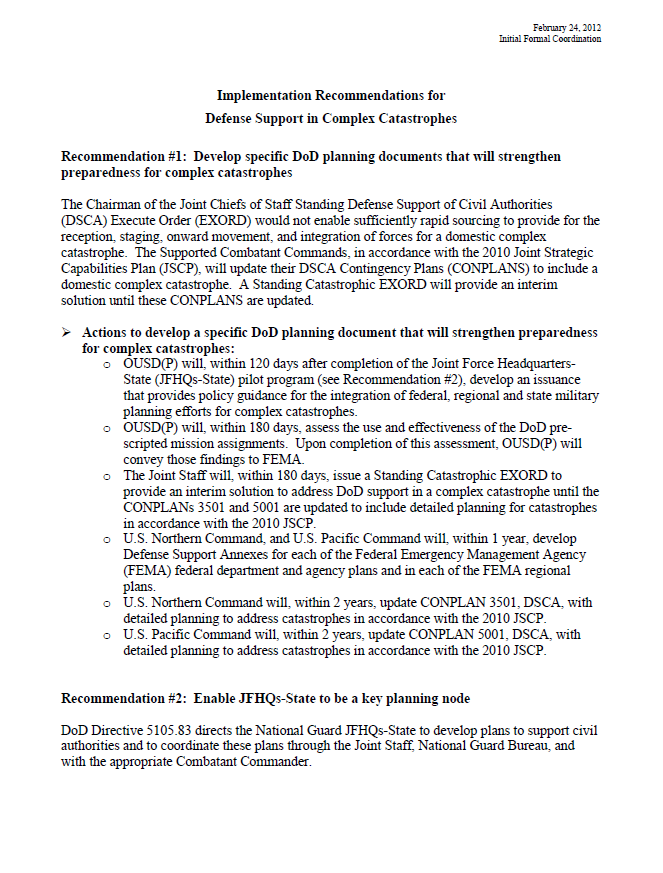Recommendation #1: Develop specific DoD planning documents that will strengthen preparedness for complex catastrophes
The Chairman of the Joint Chiefs of Staff Standing Defense Support of Civil Authorities (DSCA) Execute Order (EXORD) would not enable sufficiently rapid sourcing to provide for the reception, staging, onward movement, and integration of forces for a domestic complex catastrophe. The Supported Combatant Commands, in accordance with the 2010 Joint Strategic Capabilities Plan (JSCP), will update their DSCA Contingency Plans (CONPLANS) to include a domestic complex catastrophe. A Standing Catastrophic EXORD will provide an interim solution until these CONPLANS are updated.
Actions to develop a specific DoD planning document that will strengthen preparedness for complex catastrophes:
o OUSD(P) will, within 120 days after completion of the Joint Force Headquarters-State (JFHQs-State) pilot program (see Recommendation #2), develop an issuance that provides policy guidance for the integration of federal, regional and state military planning efforts for complex catastrophes.
o OUSD(P) will, within 180 days, assess the use and effectiveness of the DoD prescripted mission assignments. Upon completion of this assessment, OUSD(P) will convey those findings to FEMA.
o The Joint Staff will, within 180 days, issue a Standing Catastrophic EXORD to provide an interim solution to address DoD support in a complex catastrophe until the CONPLANs 3501 and 5001 are updated to include detailed planning for catastrophes in accordance with the 2010 JSCP.
o U.S. Northern Command, and U.S. Pacific Command will, within 1 year, develop Defense Support Annexes for each of the Federal Emergency Management Agency (FEMA) federal department and agency plans and in each of the FEMA regional plans.
o U.S. Northern Command will, within 2 years, update CONPLAN 3501, DSCA, with detailed planning to address catastrophes in accordance with the 2010 JSCP.
o U.S. Pacific Command will, within 2 years, update CONPLAN 5001, DSCA, with detailed planning to address catastrophes in accordance with the 2010 JSCP.
Recommendation #2: Enable JFHQs-State to be a key planning node
DoD Directive 5105.83 directs the National Guard JFHQs-State to develop plans to support civil authorities and to coordinate these plans through the Joint Staff, National Guard Bureau, and with the appropriate Combatant Commander.
Actions to enable the JFHQ-State to be a key planning node:
o OUSD(P) will, within 120 days, institute a pilot program at five designated JFHQs-State to develop methods to improve coordination between federal and state planning efforts. On completion of the pilot program, make recommendations on how to expand the program to the remaining states and territories.
o U.S. Northern Command and U.S. Pacific Command will, in coordination with National Guard Bureau, develop processes and procedures to annually assess the effectiveness of coordination and integration of federal and state planning efforts.
Recommendations #3: Improve DoD’s Support to National Preparedness
Military readiness plays an integral part of DoD support in complex catastrophes and to its overall role in supporting national preparedness. The current readiness system however is not designed to assess and sustain readiness for domestic complex catastrophes.
Actions to improve DoD’s support to national preparedness:
o OUSD(P) will, within 90 days, identify best practices for preparedness and response across DoD Components. Once identified, publish guidance on the promotion of these best practices within the Department. This guidance will include ways to incentivize best practice implementation and recognize outstanding achievement in their implementation. OUSD(P) will annually update these best practices and recognize DoD Component achievement.
o OUSD(P&R) will, within 120 days, develop recommendations for how installation commanders will report DoD readiness for capabilities other than operational forces to the Commanders, U.S. Northern Command and U.S. Pacific Command.
o OUSD(P&R) will, within 120 days, develop recommendations for assessing DoD support of national preparedness.
o OUSD(P&R) will, within 180 days, develop assessment criteria and a process to assess preparedness within DoD.
Recommendation #4: Identify and facilitate DoD senior-leader decisions that will enable a faster DoD response
DoD senior leaders must make a broad range of decisions required to initiate and maintain a large-scale, rapid DoD response to domestic incidents. In order to do this successfully, leaders must have shared situational awareness and anticipate requirements for DoD support. The primary focus of this efforts will be on supporting senior DoD leadership decision making. This effort wil also make recommendations to guide subsequent work to ensure that the DoD senior leader situational awareness initiative will be aligned with other key federal and state situational awareness improvement efforts currently underway.

